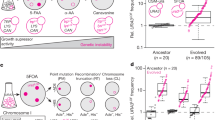Summary
The range of incidences of azaguanine-resistant colonies in cultures of fibroblasts from 16 unrelated humans was 0.4×10-6 to 19×10-6 and the mean value was 4.1×10-6. A fluctuation test showed that most or all of the mutant colonies derived from mutations that occurred during in vitro proliferation of the fibroblasts and before exposure to azaguanine. The estimated rate of spontaneous mutation was 0.45×10-6 to 1.8×10-6 per cell generation. At least ten independent mutants, comprising two general classes, were studied. Class I mutants were a minority and resembled cells from boys having the Lesch-Nyhan syndrome: they had very little HG-PRT activity, showed maximum resistance to azaguanine and could not utilize hypoxanthine for growth. At least 90% of the mutants were in Class II: their apparent HG-PRT activities ranged between normal and Lesch-Nyhan amounts, they were partially sensitive to azaguanine and they could utilize hypoxanthine. Some Class II mutants resembled cells cultured from a family having an X-chromosomal mutant gene that does not cause the Lesch-Nyhan syndrome but does confer resistance to azaguanine, although the quantity of HG-PRT activity is apparently normal and hypoxanthine can be utilized. Electrophoretic differences between the HG-PRT activities of normal and mutant strains were not detected but other qualitative alterations were observed in some mutants.
Similar content being viewed by others
References
Adye, J. C., Gots, J. S.: Further studies of genetically altered purine nucleotide pyrophosphorylases of Salmonella. Biochim. biophys. Acta (Amst.) 118, 344 (1969).
Albertini, R., DeMars, R.: Diploid azaguanine-resistant mutants of cultured human fibroblasts. Science 169, 482 (1970).
Albertini, R., DeMars, R.: Detection and quantification of X-ray induced mutation in cultured, diploid, human fibroblasts. Manuscript in preparation (1972).
Bakay, B., Nyhan, W. L.: The separation of adenine and hypoxanthine-guanine phosphoribosyl transferases isoenzymes by disc gel electrophoresis. Biochem. Genet. 5, 81 (1971).
Benke, P. J., Herrick, N.: Azaguanine-resistance as a manifestation of a new form of metabolic overproduction of uric acid. Amer. J. Med. 52, 547 (1972).
Bridges, B. A., Huckle, J.: Mutagenesis of cultured mammalian cells by X-irradiation and ultraviolet light. Mutat. Res. 10, 141 (1970).
Chu, E. H. Y., Brimer, P., Jacobson, K. B., Merriam, E. V.: Mammalian cell genetics I. Selection and characterization of mutations auxotrophic for L-glutamine or resistant to 8-azaguanine in Chinese hamster cells in vitro. Genetics 62, 359 (1969).
Davidson, J. D., Winter, T. S.: Purine nucleotide pyrophosphorylases in 6-mercaptopurine — sensitive and-resistant human leukemias. Cancer Res. 24, 261 (1964).
DeMars, R.: A temperature-sensitive glucose-6-phosphate dehydrogenase in mutant cultured human cells. Proc. nat. Acad. Sci. (Wash.) 61, 562 (1968).
DeMars, R.: Genetic studies of HG-PRT deficiency and the Lesch-Nyhan syndrome with cultured human cells. Fed. Proc. 30, 944 (1971).
E.C.2.4.2.8 Enzyme Nomenclature: Recommendations of 1964. Amsterdam: Elsevier 1965.
Felix, J. S., DeMars, R., King, W.: manuscript in preparation (1972).
Friedman, R., Seegmiller, J. E., Sukak-Sharpe, J. H.: Metabolic cooperation between genetically marked human fibroblasts in tissue culture. Nature (Lond.) 220 272 (1968).
Ham, R. G.: An improved nutrient solution for diploid Chinese hamster and human cell lines. Exp. Cell Res. 29, 515 (1963).
Harris, M.: Mutation rates in cells at different ploidy levels. J. Cell. Physiol. 78, 177 (1971).
Henderson, J. F., Brox, L. W., Kelley, W. M., Rosenbloom, F. M., Seegmiller, J. E.: Kinetic properties of hypoxanthine-guanine phosphoribosyltransferase. J. biol. Chem. 243, 2514 (1968).
Kahan, B., DeMars, R.: Unpublished.
Kelley, W. N., Greene, M. L., Rosenbloom, F. M., Henderson, J. F., Seegmiller, J. E.: Hypoxanthine-guanine phosphoribosyl c transferase deficiency in gout. Ann. intern. Med. 70, 155 (1969).
Luria, S. E., Delbrück, M.: Mutations of bacteria from virus sensitivity to virus resistance. Genetics 28, 491 (1943).
McDonald, J. A., Kelley, W. N.: Lesch-Nyhan syndrome: altered kinetic properties of mutant enzyme. Science 171, 689 (1971).
Migeon, B. R., Der Kaloustian, V. M., Nyhan, W. L., Young, W. J., Childs, B.: X-linked hypoxanthine-guanine phosphoribosyltransferase deficiency: heterozygote has two clonal populations. Science 160, 425 (1968).
Nabholz, M., Miggiano, V., Bodmer, W.: Genetic analysis with human-mouse somatic cell hybrids. Nature (Lond.) 223, 358 (1969).
Nyhan, W. L.: Clinical features of the Lesch-Nyhan syndrome. Fed. Proc. 27, 1027, 1034 (1968).
Oyama, V. L., Eagle, H.: Measurement of cell growth in tissue culture with a phenol reagent (Folin-Ciocalteau). Proc. Soc. exp. Biol. (N.Y.) 91, 305 (1956).
Rappaport, H., Demars, R.: to be published.
Rodbard, E., Chrambach, A.: Estimation of molecular radius, free mobility and valence using polyacrylamide gel electrophoresis. Analyt. Biochem. 40, 95 (1971).
Rosenbloom, F. M., Kelley, W. N., Henderson, J. F., Seegmiller, J. E.: Lyon hypothesis and X-linked disease. Lancet 1967 II, 305.
Russell, J. D., DeMars, R.: UDP-glucose: α-D-galactose-1-phosphate uridylyltransferase activity in cultured human fibroblasts. Biochem. Genet. 1, 11 (1967).
Salzmann, J., DeMars, R., Benke, P.: Single-allele expression at an X-linked hyperuricemia locus in heterozygous human cells. Proc. nat. Acad. Sci. (Wash.) 60, 545 (1968).
Seegmiller, J. E., Rosenbloom, F. M., Kelley, W. N.: Enzyme defect associated with a sexlinked human neurological disorder and excessive purine synthesis. Science 155, 1682 (1967).
Subak-Sharpe, J. H., Burk, R. R., Pitts, J. D.: Metabolic cooperation between biochemically marked mammalian cells in tissue culture. J. Cell Sci. 4, 353 (1969).
Szybalski, W., Szybalska, E. H., Ragni, G.: Genetic studies with human cell lines. Nat. Cancer Inst. Monogr. 7, 75–89 (1962).
Vogel, F.: Mutations in man. Genetics Today. Proc. XI Int. Congr. Genet. The Hague 1963. New York: Pergamon Press 1964.
Weiss, M. C., Green, H.: Human-mouse hybrid cell lines containing partial complements of human chromosomes and functioning human genes. Proc. nat. Acad. Sci. (Wash.) 58, 1104 (1967).
Author information
Authors and Affiliations
Additional information
Paper No. 1558 from the Laboratory of Genetics.
Supported by N.I.H. Grants GM-06983 and GM-15422 and by a grant from the Food Research Institute of The University of Wisconsin, Madison, Wisconsin.
Supported by Grant He 753-1 from Die Deutsche Forschungsgemeinschaft.
Rights and permissions
About this article
Cite this article
DeMars, R., Held, K.R. The spontaneous azaguanine-resistant mutants of diploid human fibroblasts. Humangenetik 16, 87–110 (1972). https://doi.org/10.1007/BF00393992
Issue Date:
DOI: https://doi.org/10.1007/BF00393992




